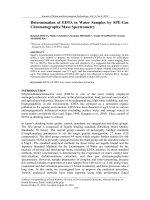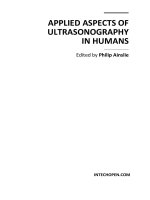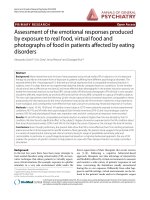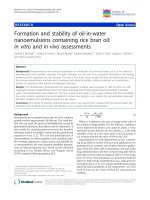Separation of oil in water emulsion by tangential flow microfiltration process
Bạn đang xem bản rút gọn của tài liệu. Xem và tải ngay bản đầy đủ của tài liệu tại đây (3.13 MB, 222 trang )
SEPARATION OF OIL IN WATER EMULSION
BY TANGENTIAL FLOW MICROFILTRATION PROCESS
WAN THIAM TEIK
(B. Eng. (Hons.), UTM, M.Eng., NTU )
A THESIS SUBMITTED
FOR THE DEGREE OF DOCTOR OF PHILOSOPHY.
DEPARTMENT OF MECHANICAL ENGINEERING.
NATIONAL UNIVERSITY OF SINGAPORE.
2014
DECLARATION
I hereby declare that the thesis is my original work and it has been written by
me in its entirety. I have duly acknowledged all the sources of information
which have been used in the thesis.
This thesis has also not been submitted for any degree in any university
previously.
_________________
Wan Thiam Teik
14 July 2014
i
ABSTRACT
Management of produced water is a major issue offshore. The use of subsea pumps and
flow regulating device is producing emulsions. The presence of surfactant film in the
production stream also stabilizes the emulsions, prevent droplets coalescence and
introduce challenges to current separation technologies. The existing subsea produced
water separation system uses large and bulky conventional gravity separators which have
managed to reduce the residual content to 100-200 mg/l only, insufficient to meet the
regulatory requirement for direct disposal. In order to meet the regulations, additional
equipment, e.g. hydro-cyclones, coalescers, flocculation module and/of filters must be
used. Changes in conventional strategies and separation techniques may become
necessary to handle such challenge.
Microfiltration has emerged as a useful alternative for treating the oil-water emulsions to
meet the requirements. In this work, tangential flow (cross flow) microfiltration of oil-
water mixture was studied for better understanding of oil-water separation, membrane
fouling, and factors determining the membrane performance. The tangential flow
microfiltration was investigated using a ceramic 0.5 μm membrane. The experiments are
limited to oily water solution with concentration of 500 ~ 1000 ppm residual oil. For
safety reason, medium viscosity paraffin oil and heavier oil (Mobil Exxon DTE10 Excel
150) were used as substitute to crude oil. At 500 ppm (0.05%) and 1000 ppm (0.1%) oil
concentration, the ceramic 0.5 μm membrane was proven capable of producing a high
purity filtrate lower than the threshold required for offshore produced water effluent,
typically 29 mg/l residual oil in the Gulf of Mexico. At 500 ppm (0.05%) oil
ii
concentration, higher purity filtrate containing lower than 6 ppm residual oil in permeate
was proven possible at a trans-membrane pressure not exceeding 2.5 bars. The results
attained were useful for evaluating the potential of tangential flow microfiltration process
in the produced water treatment, with respect to the suitability to fulfil the regulatory
requirement for disposal.
However, membrane has a major drawback in the form of fouling. For the objective of
control the fouling, a novel idea of having in-situ cleaning using ultrasound cavitations
allowing remediation of a polluted surface during filtration was being tested. The fouling
control experiments indicate significant recovery of filter permeability by the assistance
of ultrasound. At 500 ppm (0.05%) oil concentration, 15.07% recovery in permeability
were recorded with mean filtration capacity to improve from 2749.6 L m
−2
h
−1
to 2389.4
L m
−2
h
−1
. Significant decline in resistance of 18.93% indicates reduced fouling and the
energy consumption required for maintaining the filtration flux, which may be used to
supply the energy required for ultrasound cleaning. Encouraging results shows it is
indeed possible to conduct in-situ cleaning while the filtration is still in operation. The
combined mechanism the tangential flow microfiltration and ultrasound cavitations, may
offers an option for future treatment of some previously difficult separation application at
remote operation, such as underwater applications, which is currently having difficulty
for access and maintenance. The ultrasound enhanced microfiltration process can also be
customized into a small diameter compact solution that will help address issues related to
produced-water management at subsea in the future. Operators can minimize water by
reducing the volume of water brought to the land surface or the platform by separating oil
and water remotely at subsea.
iii
ACKNOWLEDGEMENTS
I take a great pleasure to express my gratitude to my supervisor, Associate Professor Loh
Wai Lam, whose expertise, understanding, and patience, added considerably to my
graduate experience.
I would like to express my gratitude to Professor Lim Tee Tai for his permission to set up
a test rig in the Fluid Mechanics Lab. Thanks also goes out to the officers and technicians
for the assistance they provided at all levels of the research project.
I would like to acknowledge Dr. Nguyen Dinh Tam and Dr. Valente Hernandez Perez
for the contribution of their knowledge, time and the feedbacks to this work. Special
thanks to my fellow colleagues, Vivek Kolladikkal Premanadhan, Ko Ko Naing and Zhao
Yuqiao for their friendship and the technical assistance throughout my graduate program.
Appreciation also goes out to Tang Yan and Wang Zheng for their participation in some
of the works.
I must acknowledge my dear wife, Ling Chih, for having encouraged me to complete this
work and take the next important step in my life. Also thanks to my family for the
support they provided me through my entire life.
Finally, I recognize that this research would not have been possible without the financial
assistance of National University of Singapore under research scholarship.
iv
TABLE OF CONTENTS
ABSTRACT i
ACKNOWLEDGEMENTS iii
TABLE OF CONTENTS iv
LIST OF TABLES viii
LIST OF FIGURES ix
NOMENCLATURE xv
CHAPTER 1. INTRODUCTION 1
1.1 Oil-In-Water Emulsions and Produced Water Management 1
1.2 Limitation of Conventional Separation Technologies 2
1.3 Objectives 6
1.4 Scope and Constraints 7
1.5 Thesis Outline 8
CHAPTER 2. LITERATURE REVIEW 11
2.1 Tangential Flow Microfiltration for Separation of Oil in Water Emulsion 11
2.2 Ultrasound Separation Techniques 16
2.3 Membrane Fouling 19
2.4 Emerging Techniques for the Prevention of Membrane Fouling 21
2.5 Importance of the Research 26
CHAPTER 3. MODELLING OF FLOWS THROUGH POROUS MEDIA FILTER
28
3.2 Momentum Equation for Flow through Porous Media 29
v
3.3 Energy Equation for Flow through Porous Media 31
3.4 Deriving Porous Coefficient Based on Experimental Data 32
3.5 CFD Analysis 33
CHAPTER 4. METHODOLOGY 35
4.1 Experimental Facilities 35
4.2 Physical Properties of Paraffin Oil 39
4.3 Preparation of Oily Water Emulsion 41
4.4 Permeability and Flow Resistance 44
4.5 Ceramic Membrane and Hydrophilicity 48
4.6 Dead-end versus Tangential Flow Microfiltration 51
4.7 Experimental Results and Oil Rejection Efficiency 54
4.8 Residual Oil Measurements and TD-500D Oil in Water Meter 55
4.9 Calibration of TD-500D Oil in Water Meter 57
CHAPTER 5. EXPERIMENTAL RESULTS OF THE TANGENTIAL FLOW
MICROFILTRATION EXPERIMENTS 62
5.1 Calibration of TD-500D Meter 62
5.2 Series Run versus Continuous Runs 64
5.3 Temperature Dependent Viscosity and Flow Permeability 65
5.4 Effects of Fouling on Membrane Permeability and Flux 66
5.5 Effects of Pressure on Filtration Capacity 76
5.6 Effects of Tangential Flow (Cross-flow) Velocity on Flow Permeability 77
5.7 Permeate Quality and Data Analysis 83
5.8 Effects of Pressure on Oil Rejection Efficiency 88
5.9 Effects of Feed Concentration on Oil Rejection Efficiency 93
5.10 Effects of Cleaning Strategies on the Membrane Permeability 94
5.11 SUMMARY 96
vi
CHAPTER 6. EXPERIMENTS FOR FOULING CONTROL 99
6.1 Fouling Control 99
6.2 Fouling Control Measures by Ultrasonic Cavitations 101
6.3 Fouling Control Experiments on 0.5 μm Dead-End Filtration Ceramic Filter 102
6.4 Fouling Control Experiments on 0.5 μm Tangential Flow Microfiltration Ceramic
Filter 112
6.5 SUMMARY 130
CHAPTER 7. SUMMARY AND CONCLUSIONS 134
7.1 Summary 134
7.2 Final Conclusions 136
CHAPTER 8. RECOMMENDATIONS 138
8.1 Challenges and Opportunity 138
8.2 Recommendations for Future Designs in Produced Water Management 140
8.3 Recommendations for Fouling Control Experiments 142
8.4 Recommendations for Alternative Membranes 145
8.5 Recommendations for Oil Contents Measurements 149
8.6 Recommendations for Future Works 152
REFERENCES 155
APPENDICES 162
APPENDIX A. CHARATERISTICS OF PRODUCED WATER 163
APPENDIX B. REGULATORY STANDARD FOR OVERBOARD DISPOSAL OF
PRODUCED WATER 172
vii
APPENDIX C. FLOW SAMPLING EFFICIENCY. 173
APPENDIX D. RAW DATA FOR MICROFILTRATION EXPERIMENT 177
APPENDIX E. RAW DATA FOR SAMPLING MEASUREMENTS 182
APPENDIX F. RAW DATA FOR FOULING CONTROL EXPERIMENTS 186
APPENDIX G. TECHNICAL SPECIFICATIONS ……………………………… 202
viii
LIST OF TABLES
Table 2.5-1 Subsea processing classification.
Table 5.1-1 Fluorescence response for water samples with known oil concentration.
Table 5.1-2 Calibrated results in ppm residual oil content for various water samples.
Table 5.4-1 Tangential flow velocity versus rate of feed (0.5 μm ceramic
microfiltration membrane, oil-water feed of 1000 ppm oil concentration).
Table 5.4-2 Comparison of flow permeability, resistance and filtration capacity during
the steady state resistance (0.5 μm ceramic microfiltration membrane, oil-
water feed with 500 ppm and 1000 ppm oil concentration respectively,
Experiment 1 to 2, Appendix D.1 an D.2).
Table 5.7-1 Physical properties of liquids used in the experiments.
Table 5.7-2 Standard deviation for permeate water sample (0.5 μm ceramic
microfiltration membrane, oil-water feed of 1000 ppm oil concentration,
Appendix D.1).
Table 5.7-3 Standard deviation feed water samples (0.5 μm ceramic microfiltration
membrane, oil-water feed of 1000 ppm oil concentration, Appendix D.1).
Table 5.8-1. Filtrate quality (in ppm oil) and oil rejection efficiency (%) versus trans-
membrane pressure (0.5 μm ceramic microfiltration membrane, oil-water
feed of 500 ppm oil concentration, Appendix E.2).
Table 5.9-1 Oil rejection efficiencies (%) versus trans-membrane pressure and the feed
concentration using a 0.5 μm ceramic microfiltration membrane.
Table 6.3-1 Fouling control experiment and summary of experimental data (Case 1:
0.5 μm BACFREE dead end ceramic membrane, 3% by vol. oil-water
mixture, Appendix F.1).
Table 6.3-2 Fouling control experiment and permeability history (Case 2: 0.5 μm
BACFREE dead end ceramic membrane, 3% by vol. oil-water mixture,
Appendix F.2).
Table 6.4-1 Mean permeability and flow resistance values (Case 3 to Case 7: 0.5 μm
Doulton ceramic microfiltration membrane).
ix
LIST OF FIGURES
Figure 1.2-1 Oil emulsion droplets are stabilized with surfactant molecules.
Figure 1.2-2 Typical oil particles size distribution.
Figure 2.2-1 Experimental apparatus.
Figure 2.2-2 A cross section of the separation channel.
Figure 2.2-3 Microscopic image of the main flow channel with and without ultrasonic
actuation (frequency 6.2 MHz, particle flow 0.01 ml/min).
Figure 2.2-4 The acoustic driven porous media filtration process.
Figure 2.3-1 Sketch of hydrodynamic bridging of particles.
Figure 2.4-1 Illustrations of insert in filtration test.
Figure 2.4-2 VSEP versus cross flow filtration.
Figure 2.4-3 VSEP resonating drive system.
Figure 2.4-4 Experimental set-up for ultrasound-assisted cleaning of polymeric
membranes in a cross flow unit.
Figure 2.4-5 Filtration capacity with and without ultrasound.
Figure 4.1-1 Multi-purpose two phase test rig.
Figure 4.1-2 Flow schematic for multi-purpose two phase test rig.
Figure 4.1-3 Flow schematic for tangential flow microfiltration loop.
Figure 4.1-4 Flow schematic for back-flush cleaning loop.
Figure 4.2-1 100 mL of coloured paraffin oil is weighed to determine the density.
Figure 4.2-2 HAAKE MARS rotational rheometer.
Figure 4.2-3 The result of viscosity measurement.
Figure 4.3-1 Mixer c/w d.c. motor and speed control (left); Homogenization in progress
(right).
Figure 4.3-2 90 L clean water was added with 90 mL paraffin oil to give a feed
concentration of 1000 ppm of residual oil content (left); Milky white
x
colour emulsion after homogenization (middle); Stable oil in water sample
which doesn’t separate by gravity after 5 days later (right).
Figure 4.4-1 Possible resistances against solvent transport.
Figure 4.5-1 A wetting test on a ceramic membrane wetted with clean water: A drop of
clean water quickly disappeared into the membrane (left); A drop of
paraffin oil was added at the same time, still retain its drop forms, a
minutes after the test (right).
Figure 4.5-2 Hydrophilic surface has lower water-membrane-air contact angle.
Figure 4.6-1 Static filtration versus cross-flow filtration.
Figure 4.6-2 A tangential flow ceramic microfiltration filter modified from an available
0.5 μm Doulton dead end hollow filter.
Figure 4.6-3 The micro-filter is installed at upright position.
Figure 4.8-1 TD-500D oil in water analyser.
Figure 4.9-1 Hexane is used as solvent for extracting oil from water sample.
Figure 4.9-2 Linearity check.
Figure 4.9-3 Mini-cell cuvette and 8 mmm cuvette (left); 8 mm cuvette fitted into
adaptor and placed in the meter for measurement (right).
Figure 4.9-4 Diagnostic information.
Figure 5.4-1 Permeability history and fouling analysis (0.5 μm ceramic microfiltration
membrane, oil-water feed of 1000 ppm oil concentration, Experiment 1,
Appendix D.1).
Figure 5.4-2 The effects of fouling on permeability (0.5 μm ceramic microfiltration
membrane, oil-water feed of 1000 ppm oil concentration, Experiment 1,
Appendix D.1).
Figure 5.4-3 The effects of fouling on flow resistance (0.5 μm ceramic microfiltration
membrane, oil-water feed of 1000 ppm oil concentration, Experiment 1,
Appendix D.1).
Figure 5.4-4 Formation of dirt cake on membrane due to concentration polarization.
Figure 5.4-5 Fouling of ceramic membrane after a number of operations.
Figure 5.4-6 Tangential flow velocity versus rate of feed (0.5 μm ceramic
microfiltration membrane, oil-water feed of 1000 ppm oil concentration).
xi
Figure 5.4-7 Permeability history and fouling analysis (0.5 μm ceramic microfiltration
membrane, oil-water feed of 500 ppm oil concentration, Experiment 2,
Appendix D.2).
Figure 5.4-8 The effects of fouling on permeability (0.5 μm ceramic microfiltration
membrane, oil-water feed of 500 ppm oil concentration, Experiment 2,
Appendix D.2).
Figure 5.4-9 The effects of fouling on flow resistance (0.5 μm ceramic microfiltration
membrane, oil-water feed of 500 ppm oil concentration, Experiment 2,
Appendix D.2).
Figure 5.5-1 Effects of pressure on filtration capacity of a 0.5 μm ceramic
microfiltration membrane from run 01 to 20 (Oil-water feed of 1000 ppm
oil concentration, First 15 runs with only clean water feed, Appendix D.1).
Figure 5.5-2 Effects of pressure on filtration capacity of a 0.5 μm ceramic
microfiltration membrane from run 15 to 20 (Oil-water feed of 1000 ppm
oil concentration, First 15 runs with only clean water feed, Appendix D.1).
Figure 5.6-1 Effects of tangential flow velocity on the permeability (0.5 μm ceramic
microfiltration membrane, oil-water feed of 1000 ppm oil concentration,
Appendix D.1).
Figure 5.6-2 Effects of tangential flow velocity on flow resistance (0.5 μm ceramic
microfiltration membrane, oil-water feed of 1000 ppm oil concentration,
Appendix D.1).
Figure 5.6-3 Reynolds numbers versus tangential flow velocity (0.5 μm ceramic
microfiltration membrane, oil-water feed of 1000 ppm oil concentration,
Appendix D.1).
Figure 5.7-1 Water samples collected at filtration end for experiments in different
pressure ranges from 1 barg (left) to 3.5 barg (right) for an oil-water-feed
of 1000 ppm oil concentration using 0.5 μm ceramic microfiltration
membrane.
Figure 5.7-2 Water samples collected during tangential flow microfiltration of a feed of
1000 ppm oil in water using 0.5 μm ceramic membrane at trans-membrane
pressure of 2.0 barg: permeate water sample with 1000 ppm oil
concentration (middle); Permeation water sample from the tangential
microfiltration of a feed of 1000 ppm of oil in water (right).
Figure 5.8-1 Filtrate quality in ppm residual oil content for tangential flow
microfiltration experiments with (a) tap water; (b) oil-water feed of 1000
ppm oil concentration (0.5 μm ceramic microfiltration membrane).
xii
Figure 5.8-2 Oil rejection efficiency (0.5 μm ceramic microfiltration membrane, oil-
water feed of 1000 ppm oil concentration, Appendix E.1).
Figure 5.8-3 An oil droplet at the entrance of idealised pore.
Figure 5.8-4 The comparison of particle size distribution of cakes, in the presence of
turbulence promoter (TP), or without (NTP).
Figure 6.2-1 Ultrasonic cavitations within the liquid to prevent fouling materials from
depositing on the membrane surface.
Figure 6.3-1 Schematics of a simple test rig for ultrasound cleaning experiments.
Figure 6.3-2 A 0.5 μm pore size BACFREE dead end ceramic filter.
Figure 6.3-3 Fouling control experiment and permeability history (Case 1: 0.5 μm
BACFREE dead end ceramic membrane, 3% by vol. oil-water mixture,
Appendix F.1).
Figure 6.3-4 Fouling control experiment and permeability history (Case 2: 0.5 μm
BACFREE dead end ceramic membrane, 3% by vol. oil-water mixture,
Appendix F.2).
Figure 6.3-5 Fouling control experiment and permeability history (Case 1 & 2: 0.5 μm
BACFREE dead end ceramic membrane, 3% by vol. oil-water mixture,
Appendix F.1 & F.2).
Figure 6.3-6 Fouling control experiment and flow resistance history (Case 1 & 2: 0.5
μm BACFREE dead end ceramic membrane, 3% by vol. oil-water mixture,
Appendix F.1 & F.2).
Figure 6.4-1 Schematics of a simple test rig for ultrasounic cleaning experiments.
Figure 6.4-2 Ultrasound cleaning tank equipped with 4 x 50 W x 38 kHz ultrasonic
transducers.
Figure 6.4-3 0.5 μm pore size ceramic micro-filter and the stainless steel filtration
housing.
Figure 6.4-4 Fouling control experiment and flow permeability history (Case 3: 0.5 μm
Doulton ceramic microfiltration membrane, clean water feed, Appendix
F.7).
Figure 6.4-5 Fouling control experiment and flow resistance history (Case 3: 0.5 μm
Doulton ceramic microfiltration membrane, clean water feed, Appendix
F.7).
xiii
Figure 6.4-6 Fouling control experiment and flow permeability history (Case 4: 0.5 μm
Doulton ceramic microfiltration membrane, 0.1 % by vol. oil-water
mixture, Appendix F.3).
Figure 6.4-7 Fouling control experiment and flow resistance history (Case 4: 0.5 μm
Doulton ceramic microfiltration membrane, 0.1 % by vol. oil-water
mixture, Appendix F.3).
Figure 6.4-8 Fouling control experiment and flow permeability history (Case 5: 0.5 μm
Doulton ceramic microfiltration membrane, 0.05 % by vol. oil-water
mixture, Appendix F.5).
Figure 6.4-9 Fouling control experiment and flow resistance history (Case 5: 0.5 μm
Doulton ceramic microfiltration membrane, 0.05 % by vol. oil-water
mixture, Appendix F.5).
Figure 6.4-10 Fouling control experiment and flow permeability history (Case 6: 0.5 μm
Doulton ceramic microfiltration membrane, 0.1 % by vol. oil-water
mixture, Appendix F.4).
Figure 6.4-11 Fouling control experiment and flow resistance history (Case 6: 0.5 μm
Doulton ceramic microfiltration membrane, 0.1 % by vol. oil-water
mixture, Appendix F.4).
Figure 6.4-12 Fouling control experiment and flow permeability history (Case 7: 0.5 μm
Doulton ceramic microfiltration membrane, 0.05 % by vol. oil-water
mixture, Appendix F.6).
Figure 6.4-13 Fouling control experiment and flow resistance history (Case 7: 0.5 μm
Doulton ceramic microfiltration membrane, 0.05 % by vol. oil-water
mixture, Appendix F.6)
Figure 6.4-14 Fouling control experiment and flow permeability history (Case 3 to Case
7: 0.5 μm Doulton ceramic microfiltration membrane).
Figure 6.4-15 Fouling control experiment and flow resistance history (Case 3 to Case 7:
0.5 μm Doulton ceramic microfiltration membrane).
Figure 8.3-1 Proposed direct mounting of the ultrasonic transducers on the stainless
steel housing of the microfiltration unit.
Figure 8.4-1 SEM photo of the perforated membrane of a micro-sieve made with
interference lithography.
Figure 8.4-2 Calculated clean water flux for circularly micro-sieve with a porosity of
20% and a membrane thickness equal to the pore diameter.
Figure 8.4-3 Sintered wire mesh filters made of stainless steel.
xiv
Figure 8.5-1 The proposed rotavapor distillation equipment as alternative method of
measuring the oil content.
xv
NOMENCLATURE
α - permeation constant (N/m).
γ - the porosity of the medium (dimensionless).
μ - dynamic viscosity of liquid (N.s/m
2
).
σ - standard deviation (dimensionless).
1/α - viscous inertia resistance (m/N)
k
eff
- effective thermal conductivity of the medium (W/m.K).
k
f
- fluid phase thermal conductivity (W/m.K).
k
s
- solid medium thermal conductivity (W/m.K).
A - the membrane surface area in contact with the liquid (m
2
).
C
P
- the measured oil concentration of permeate (ppm).
C
F
- the measured oil concentration of feed (ppm).
J - the filtration flux across the membrane (m/s).
K - permeability (or hydraulic conductivity).
R - flow resistance (bars.s/m).
R
o -
oil rejection efficiency (dimensionless).
S
i
- source term for momentum equation (Pa or N/m
2
).
V - volume of permeate collected during time t (m
3
).
CFD - computational fluid dynamics
MF - micro-filtration.
MWCO - molecular weight cut off.
NF - nano-filtration.
NORM - naturally occurring radioactive materials.
PFD - process flow disruption
xvi
RO - reverse osmosis.
TMP - trans-membrane pressure.
UF - ultra-filtration.
1
CHAPTER 1. INTRODUCTION
1.1 Oil-In-Water Emulsions and Produced Water Management
Produced water is the largest volume waste stream during the crude oil production
process. Over the economic life of a producing field, the volume of produced water can
exceed by ten times the volume of hydrocarbon produced. During the later stages of
production, it is not uncommon to find that produced water can account for as much as
98% of the extracted fluid. With volumes to this magnitude, the disposal of produced
water becomes an important issue to both the operation and the environment [45].
Produced water is the formation water that comes to the surface with oil and gas.
It is very saline, contains dissolved hydrocarbons and organic matters (water, sands,
dissolved gases, oil emulsion droplets, formation minerals, toxicants, etc). Further
descriptions of the characteristics of produced water can refer appendix A. Produced
water is considered hazardous, improper management can harm the environment. Current
environmental regulations require the produced water be treated on the surface to meet
water quality standards prior to disposal. Thus, separation technology need be deployed
for treating the produced water to an appropriate quality prior to the disposal to the
environment.
Oil discharge limits were developed to control the amount of oil entering the sea
from produced water discharges, such control is achieved using measurements of oil in
the produced water leaving the water processing equipment [52]. The current regulations
require the “total oil and grease” content of the effluent water to be reduced to levels
2
ranging between 15 and 50 mg/l depending upon the host country (refer Appendix B).
For the instances, the U.S. EPA currently prohibits the discharge of produced water
which exceeding 29 mg/l (or 32 ppm based on volume ratio) residual oil content to the
Gulf of Mexico, as determined from an average of four samples taken within 24 hour per
month [10]. However, conventional water treating equipment does not remove soluble oil
from the water. The EPA does not differentiate between soluble and dispersed oil. Thus,
the soluble oil concentration must be subtracted from the discharge limit to indicate the
maximum amount of dispersed oil allowed in the effluent. For example, typical Gulf of
Mexico values for soluble oil concentration range from 0 to 30 mg/l, although readings as
high as 100 mg/l have been recorded [10]. With a maximum allowance of 15 mg/l is
assumed for dissolved oil, the amount of suspended oil should not exceed 14 mg/l of
residual oil content, which is approximated to around 15-16 ppm based on volume ratio.
1.2. Limitation of Conventional Separation Technologies
Oilfield produced water treating equipment in use today is designed to remove discrete
droplets of oil from the water phase. Conventional equipment such as gravity separator
and hydro-cyclone separates the dispersed phases from continuous phases according to
their density difference under the action of gravity force or centrifugal force induced by
swirling flow. As droplet moves through chokes, valves, pumps, or other constrictions in
the flow path, the droplets can be torn into smaller droplets by the pressure differential
across the devices. These small droplets can be further stabilized in the water by the
surfactants. The addition of excess production chemicals (such as surfactants) forms an
3
encapsulation of hydrophilic and/or hydrophobic particles on the oil droplets, as
illustrated in Figure 1.2-1. It can further reduce the interfacial tension so that the
coalescence and separation of small droplets become extremely difficult. As a result,
produced water after separation from oil during the primary separation process may yet
contains residual oil in form of emulsions.
Figure 1.2-1: Oil emulsion droplets are stabilized with surfactant molecules.
A typical oil droplets size distribution in produced water is illustrated in Figure
1.2-2. It is possible to have more than 20 percents of the dispersed oil exists in the form
of fine emulsions smaller than 10 μm in size. These fine emulsions are very difficult to
separate from the background phase using the conventional separation technology.
4
Figure 1.2-2: Typical oil particles size distribution curve [10].
For example, gravity separator is often used to give an initial separation of oil and
water. It would separate most oil from water, and the small quantity of remaining oil in
the water must be reduced to an acceptable limit before the water can be discharged into
the sea or re-injected for water flooding. However, gravity separator is often inefficient
when it has to deal with fine emulsion droplets. For due reason, modern gravity
separators are always assisted by coalescing technique that allows droplets to grow in
size prior to the gravity separation. However, the presence of surfactant film actually
stabilises the emulsified oils and prevents coalescence when two oil droplets collide.
Therefore, secondary treatment steps are often used to lower the residual content prior to
the discharge.
Alternatively, separation can be done with air-induced flotation tank based
systems where a fine mist of air was injected in conjunction with surfactants to float oil
droplets to the surface. This method and other conventional technologies, including
5
parallel plate coalescers and granular media filtration do not produce effluent that
consistently meets the discharge limits and re-injection requirements [8]
On the other hand, offshore oil industries have been increasingly using liquid-
liquid hydro-cyclones to separate the oily water to cut down the operating cost as well as
solving the problem of space and weight. The hydro-cyclones produce a swirling flow
which causes heavier fluid to be displaced outwardly and exit through apex, while the
lighter phase exits through the vortex finder. This centrifugal mechanism is however, less
suitable for emulsions where the dispersed phase is slightly lighter than the continuous
phase, such as oil-in-water emulsion. Hydro-cyclones are though widely used for
removing low-diameter suspended oils at the surface and down-hole, it has limitations to
separate finer oil emulsion droplet from produced water. Therefore, the oil content of the
disposal water stream from the hydro-cyclones will be limited to 200 ppm (Scott et al.,
2004). The performance of a hydro-cyclone deteriorates with drop size. A typical
rejection of 50–80% at 20 μm oil droplets is reported to decline to between 10 and 30%
for oil droplets at 10 μm drop size. Reduction of the oil particles below 20 μm drop size
requires either a different process or a method to coalesce the oil drops before passage
through the hydro-cyclone [34].
Apart from the above, there is another challenge to conventional separator about
the size of equipment at subsea environment. At shallower water, the wall thickness of
the equipment is driven by internal pressure alone. When moving to deeper field,
hydrostatic pressure dictates the wall thickness. The wall thickness is proportional to
hydrostatic pressure, increases the diameter and eventually adding the wall thickness
further. Hence, the increase in weight is disproportional to the depth. Hence, small
6
diameter compact solution with thinner wall requirement should be preferable criteria for
future subsea processing and/or down-hole application. The problems are very crucial, to
the extent which this is necessary to develop alternative technologies. There is thus an
opportunity for membranes and other new technologies that can meet current limits
across a variety of oil fields. For due reason, microfiltration has emerged as a useful
alternative for treating the oil-water emulsions for produced water management in
offshore field.
Although the tangential flow microfiltration technology has been around for
decades, it has been broadly used as filtration of solid particulates from liquid than the
separation of liquid-liquid mixture. There is only a limited attention given to the
application of microfiltration membranes to oil/water separation [2, 4, 6, 8, 9, 18, 29, 31,
34, 43]. At the same time, the mechanics of the separation mechanism is still not well
understood. Therefore, it is the aims of this thesis work to study the tangential flow (cross
flow) microfiltration of oil in water mixture for the better understanding of oil-water
separation, membrane fouling, membrane cleaning, and factors determining the
membrane performance.
1.3. Objectives
This research is aimed to develop a tangential flow microfiltration technology for
separation of oil-in-water emulsions, for potential applications in future produced water
management. The objectives include:
7
• Setting up test facility to investigate separation performance and characteristics of
tangential flow microfiltration of oil-in-water emulsions.
• Conducting extensive fundamental investigation and understanding the
mechanism of oily water separation via tangential flow microfiltration and
process factors determining the membrane performance.
• Studying the key phenomena relevant to the tangential flow microfiltration
process such as flux decline, that is essential for understanding the mechanisms of
membrane fouling.
• Propose and test a fouling control technique using the in-situ ultrasound
cavitations to maintain the filter performance for prolong duration, address the
issue of fouling while the filter is still in the operation.
• Evaluating the potential of tangential flow microfiltration process for the
treatment of produced water with respect to the suitability to fulfil the regulatory
requirements for direct discharge of purified effluent in sea.
1.4. Scope and Constraints
The experiments focus on the fundamental study of factors affecting the separation
performance such as the effects of oil concentration, tangential flow (cross flow) velocity,
trans-membrane pressure on the permeate flux rate and separation efficiency, in relation
to filter characteristics. However, the experimental study is not restricted to the









